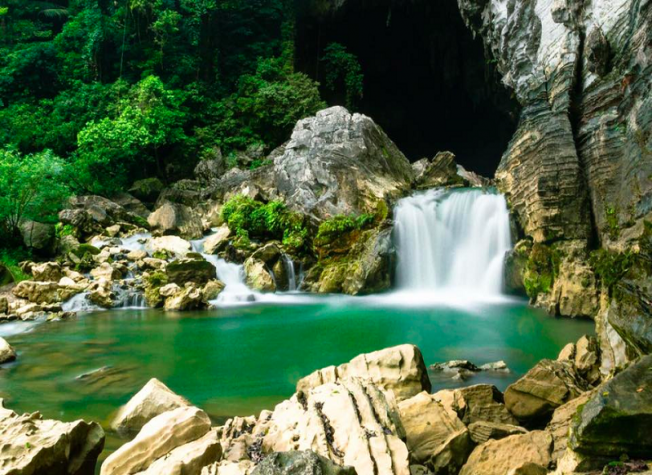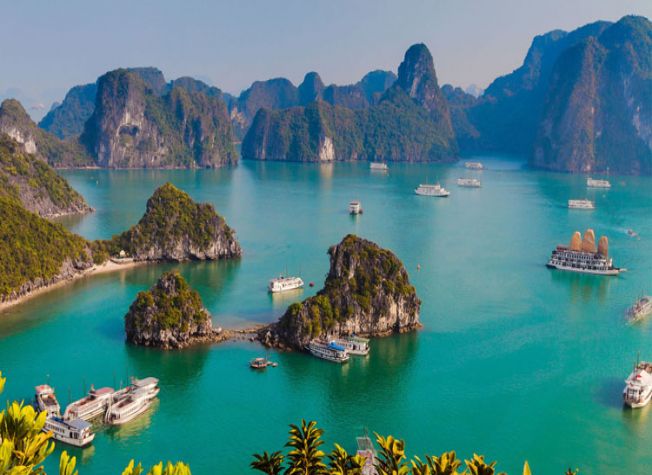Phong Nha Travel Guide
Phong Nha-Ke Bang National Park
1. History and Geology of Phong Nha-Ke Bang National Park: Phong Nha is one of the Best National Parks in Vietnam, headquarter located in Bo Trach district, and Minh Hoa district, Quang Binh province, about 50 km northwest of Dong Hoi city, about 500 km south. The park borders Hin Namno Nature Reserve in Khammouan Province, Laos to the west, 42 km east of the East Sea from the borders of the two countries.
Phong Nha-Ke Bang is located in an area of about 200,000 hectares of limestone mountains in the territory of Vietnam, the Lao territory adjacent to the national park also has an area of about 30,000 hectares of limestone mountains. The core area of the national park is 85,754 ha and a buffer zone of 195,400 ha. In August 2013, the Prime Minister decided to expand the national park to 1233.26 km2. The park was set up to protect one of the world's two largest karsts with about 300 caves and preserve the northern Truong Son ecosystem in the North Central region of Vietnam. Characteristics of this national park are limestone formations, 300 caves, underground rivers and rare and precious flora and fauna in the Vietnam Red Book and World Red Book. The caves here have a total length of more than 80 km but the English and Vietnamese cave explorers have only explored 20 km, of which 17 km in Phong Nha area and 3 km in Ke Bang area.
In April 2009, an expedition of the British Royal Cave Association discovered and announced Son Doong Cave, the largest sized cave in the world (over 5 km long, 200 m high, and 150 m wide), much larger than Deer Cave in Gunung Mulu National Park in Sarawak, Malaysia, 4 to 5 times larger than Phong Nha. During this survey, the expedition also found many other caves.
The formation of the carcass of Phong Nha-Ke Bang National Park was formed 400 million years ago, from the time of the Paleozoic period and therefore the oldest caravan in Asia.
Experiencing many major changes in stratigraphy and geomorphology, the topography of this area is very complicated. Phong Nha-Ke Bang presents impressive evidence of the history of the Earth, helping to study the history of the geological and topographical history of the region. Phong Nha-Ke Bang area is one of the distinctive and beautiful patterns of complex construction of Southeast Asia. Recognized by UNESCO as a World Natural Heritage site according to the geological and geomorphologic criteria of 2003, and secondly recognized by the UNESCO as a World Natural Heritage site with the criteria of biodiversity and ecology on 3th Jul 2015.
2. Phong Nha - Ke Bang National Park Weather: Phong Nha - Ke Bang features a “Tropical monsoon” climate. The highest temperature is sbout 32.5°C (90.5°F) and the lowest is about 17.5°C (63.5°F), with an average yearly temperature of 24.6°C (76.28°F). Annual rainfall averages nearly 1503.3 millimetres (59.19 inches).
Historical Monthly Average Temperature and Rain Falls.
| Months | High / Low (°C) | Rain |
|
January |
21.2° / 17.5° |
15.6 days |
|
February |
23.2° / 18.1° |
8.6 days |
|
March |
26.0° / 20.1° |
10.4 days |
|
April |
29.1° / 22.3° |
10.0 days |
|
May |
32.1° / 25.1° |
12.8 days |
|
June |
32.5° / 26.0° |
9.1 days |
|
July |
31.4° / 25.5° |
13.2 days |
|
August |
31.1° / 25.3° |
16.0 days |
|
September |
29.8° / 24.4° |
19.1 days |
|
October |
26.8° / 22.2° |
19.8 days |
|
November |
24.6° / 21.0° |
17.8 days |
|
December |
21.5° / 18.4° |
15.6 days |
Best Time to Visit Phong Nha Ke Bang National Park: The best time to travel to Phong Nha Ke Bang national park is from March to August. This period of time is the dry season which makes it ideal to visit the various natural attractions in and around the park. The temperatures can be warm or even hot on most days with temperatures can be touching 32°C.
3. How to Get to Phong Nha Ke Bang National Park? The popularity of Phong Nha-Ke Bang National Park has been skyrocketing of late, and it has made travelling to Phong Nha much easier than it used to be.
- Airway Travel:
Airplane Travel is the fastest and easiest way of travelling for anyone from Hanoi Airport or Ho Chi Minh City (Saigon) Airport, with less than two hours flight time to Dong Hoi city. Then you will take taxi transfer from Dong Hoi Airrport to Phong Nha Ke Bang National Park.
If you take International flights, then you need to flight to Vietnam International Airrport in Hanoi, Ho Chi Minh City then take connecting flights to Dong Hoi and Car/Taxi to Phong Nha. If you choose to land in Danang International Airrport, then you need to take private car Danang to Phong Nha.
- Hanoi (Noi Bai International Airport) – Dong Hoi Airrport – Car/Taxi to Phong Nha
- Ho Chi Minh City (Tan Son Nhat International Airport) – Dong Hoi – Car to Phong Nha
- Da Nang (Da Nang International Airport) – Private Car/Taxi to Phong Nha
If you fly into Saigon, you will need to take another flight to Dong Hoi Airport then Car/Taxi to Phong Nha National Park. If you fly into Hanoi, you can also get to Dong Hoi by flight, bus or train. From Da Nang, you can get here by bus or train.
- BUS TRAVEL:
Travelling by sleeper bus is a great way to meet travellers going to the same destination! The buses are with sleeper-type, air-conditioned, and occasionally have wi-fi. There is a small toilet at the back of some sleeper buses and they also make quick stops along the way, where you’ll find basic toilet facilities. Most bus companies make a stop in Phong Nha. Therefore, the bus option is becoming a popular budget choice among travellers.
- Hanoi to /from Phong Nha By Bus:
It is relatively easy to get to Phong Nha from Hanoi, and vice versa. Most bus companies will now make a stop in Phong Nha. Therefore, the bus option is becoming a popular budget choice among travellers, and you do not need transfer from Dong Hoi (the closest train station or airport to Phong Nha).
- Ninh Binh to/from Phong Nha by Bus:
Ninh Binh City is located on the national route from Hanoi to/from Phong Nha National Park, so you can also use the same public tourist bus to arrive at Phong Nha Ke Bang National Park.
- Halong Bay to/from Phong Nha by Bus:
If you’re planning to travel by bus from Ha Long Bay or Cat Ba Island, please note that you’ll be dropped at Dong Hoi and not Phong Nha directly. From Dong Hoi, you will need to book an additional transfer to Phong Nha.
- Hue City to/from Phong Nha by Bus:
Hue is located just about 4 hours’ drive from the jungle and caving capital of Vietnam. It is a relatively convenient travel route with buses on offer from a number of companies Hanoi to/from Hue and they always make a stop in Phong Nha.
- Da Nang (Hoi An) to/from Phong Nha Bus:
Da Nang is the biggest and busiest city in central Vietnam, with beautiful beaches, mountains, heritage sites and only a 45-minute drive from the UNESCO world-heritage town of Hoi An. It is a 7-hour bus journey between Da Nang and Phong Nha.
- TRAIN TRAVEL:
Train Travel is an enjoyable way to travel and see the countryside and meet people on the journey. It is comfortable if you purchase a ticket in a soft-sleeper with 4 beds in the cabin, so there is enough room to sit up for chatting or lie down. A hard-sleeper cabin may not provide enough room to sit up as there will be 6 beds per room. Overnight trains to Dong Hoi are also a good option as you not only get somewhere to sleep for the night, but also avoid missing out on one day of adventure.
But the train time schedules cannot be guaranteed and it only takes you to Dong Hoi City. Then you need to take car/taxi to Phong Nha National Park. Therefore, we recommend that you should take car/bus to get directly to Phong Nha. If you still love to take the train, you can check the train schedule via the Vietnam Railways official website http://dsvn.vn (English/Vietnamese) or visit https://www.baolau.com to book your train tickets in advance.
- PRIVATE TRANSFERS:
Private Car Transfer is the most convenienct way to get to Phong Nha from any city in central Vietnam. Beside that, with private car transfer, you can also make stops any time on the way to see the scenery and visit some historical sites. Adventure Journey offer the best affordabel private car with sightseeing stop Hue to/from Phong Nha, Hoi An to/from Phong Nha, Danang Airport to/from Phong Nha. Please do not hesitage to contact our travel consultants for further information and support.
Best of Vietnam

Best Vietnamese Food You Have to Try in Vietnam
Best Food in Vietnam: Vietnamese Traditional Food is top World well known to be both healthy and...

10 Best National Parks in Vietnam
Vietnam Travel Guide: If you look for the Best Wildlife Discovery Experience in Vietnam, here are...
Read More
Best Souvenir to Buy in Vietnam
If you look for Best Things to Buy when traveling to Vietnam to bring home for your family & friends...
Read More
The 10 Best Places to Visit in Vietnam
Vietnam Travel Guide: Home to an extensive collection of historical and cultural attractions,...
Read More
Top 10 Museums You Should Not Miss in Vietnam
Vietnam, 4.000 years old country has a unique and lengthy history, culture with 54 ethnic groups. It...
Read MoreFind your trip
Vietnam Best Tours
Vietnam Car Rental
Vietnam Travel Blog
- Vietnamese People: Origin, History, Culture and Traditions
- Vietnam Currency: Best ATM and Places to Exchange Money
- Vietnam Map: Regions, Cities & Provinces Map of Vietnam
- What is illegal Things in Vietnam: Rules & Laws for Tourists
- Best Time to Travel to Vietnam to Avoid the Bad Weather
- Vietnam News: Population & Religions of 54 Ethnic Groups









